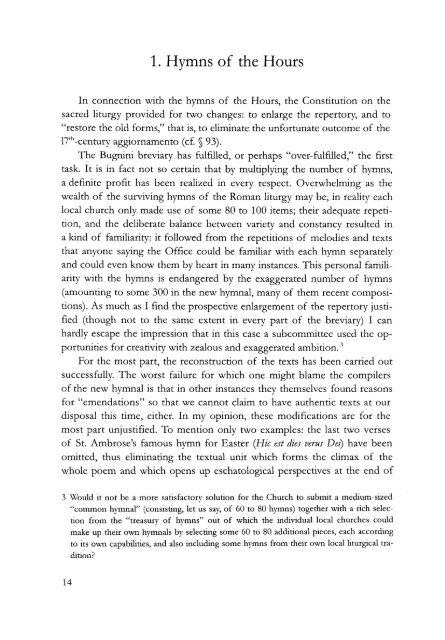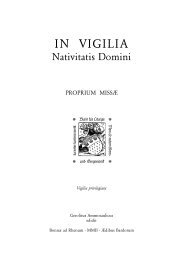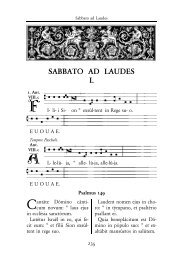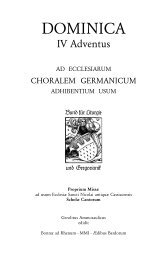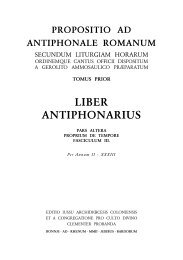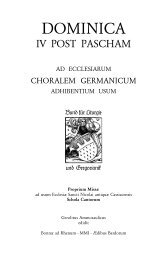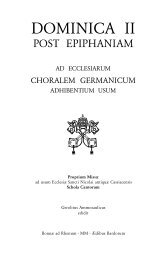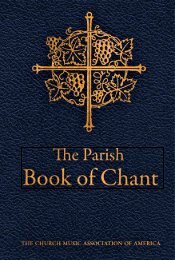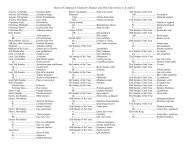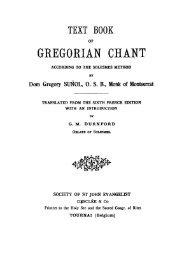The Bugnini-Liturgy and the Reform of the Reform - MusicaSacra
The Bugnini-Liturgy and the Reform of the Reform - MusicaSacra
The Bugnini-Liturgy and the Reform of the Reform - MusicaSacra
Create successful ePaper yourself
Turn your PDF publications into a flip-book with our unique Google optimized e-Paper software.
1. Hymns <strong>of</strong> <strong>the</strong> Hours<br />
In connection with <strong>the</strong> hymns <strong>of</strong> <strong>the</strong> Hours, <strong>the</strong> Constitution on <strong>the</strong><br />
sacred liturgy provided for two changes: to enlarge <strong>the</strong> repertory, <strong>and</strong> to<br />
"restore <strong>the</strong> old forms," that is, to eliminate <strong>the</strong> unfortunate outcome <strong>of</strong> <strong>the</strong><br />
17 th -century aggiornamento (cf. § 93).<br />
<strong>The</strong> <strong>Bugnini</strong> breviary has fulfilled, or perhaps "over-fulfilled," <strong>the</strong> first<br />
task. It is in fact not so certain that by multiplying <strong>the</strong> number <strong>of</strong> hymns,<br />
a definite pr<strong>of</strong>it has been realized in every respect. Overwhelming as <strong>the</strong><br />
wealth <strong>of</strong> <strong>the</strong> surviving hymns <strong>of</strong> <strong>the</strong> Roman liturgy may be, in reality each<br />
local church only made use <strong>of</strong> some 80 to 100 items; <strong>the</strong>ir adequate repetition,<br />
<strong>and</strong> <strong>the</strong> deliberate balance between variety <strong>and</strong> constancy resulted in<br />
a kind <strong>of</strong> familiarity: it followed from <strong>the</strong> repetitions <strong>of</strong> melodies <strong>and</strong> texts<br />
that anyone saying <strong>the</strong> Office could be familiar with each hymn separately<br />
<strong>and</strong> could even know <strong>the</strong>m by heart in many instances. This personal familiarity<br />
with <strong>the</strong> hymns is endangered by <strong>the</strong> exaggerated number <strong>of</strong> hymns<br />
(amounting to some 300 in <strong>the</strong> new hymnal, many <strong>of</strong> <strong>the</strong>m recent compositions).<br />
As much as I find <strong>the</strong> prospective enlargement <strong>of</strong> <strong>the</strong> repertory justified<br />
(though not to <strong>the</strong> same extent in every part <strong>of</strong> <strong>the</strong> breviary) I can<br />
hardly escape <strong>the</strong> impression that in this case a subcommittee used <strong>the</strong> opportunities<br />
for creativity with zealous <strong>and</strong> exaggerated ambition. 3<br />
For <strong>the</strong> most part, <strong>the</strong> reconstruction <strong>of</strong> <strong>the</strong> texts has been carried out<br />
successfully. <strong>The</strong> worst failure for which one might blame <strong>the</strong> compilers<br />
<strong>of</strong> <strong>the</strong> new hymnal is that in o<strong>the</strong>r instances <strong>the</strong>y <strong>the</strong>mselves found reasons<br />
for "emendations" so that we cannot claim to have au<strong>the</strong>ntic texts at our<br />
disposal this time, ei<strong>the</strong>r. In my opinion, <strong>the</strong>se modifications are for <strong>the</strong><br />
most part unjustified. To mention only two examples: <strong>the</strong> last two verses<br />
<strong>of</strong> St. Ambrose's famous hymn for Easter (Hie est dies verus Dei) have been<br />
omitted, thus eliminating <strong>the</strong> textual unit which forms <strong>the</strong> climax <strong>of</strong> <strong>the</strong><br />
whole poem <strong>and</strong> which opens up eschatological perspectives at <strong>the</strong> end <strong>of</strong><br />
3 Would it not be a more satisfactory solution for <strong>the</strong> Church to submit a medium-sized<br />
"common hymnal" (consisting, let us say, <strong>of</strong> 60 to 80 hymns) toge<strong>the</strong>r with a rich selection<br />
from <strong>the</strong> "treasury <strong>of</strong> hymns" out <strong>of</strong> which <strong>the</strong> individual local churches could<br />
make up <strong>the</strong>ir own hymnals by selecting some 60 to 80 additional pieces, each according<br />
to its own capabilities, <strong>and</strong> also including some hymns from <strong>the</strong>ir own local liturgical tradition?<br />
14


